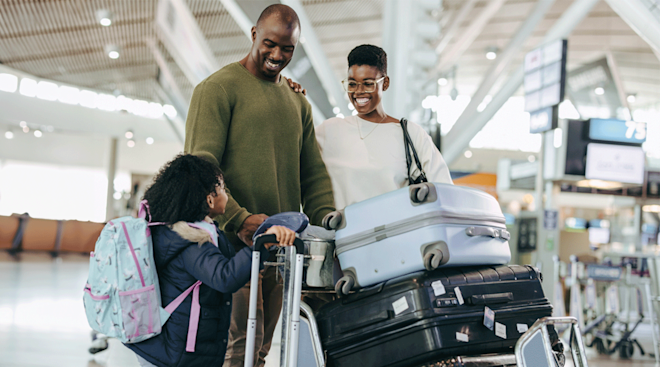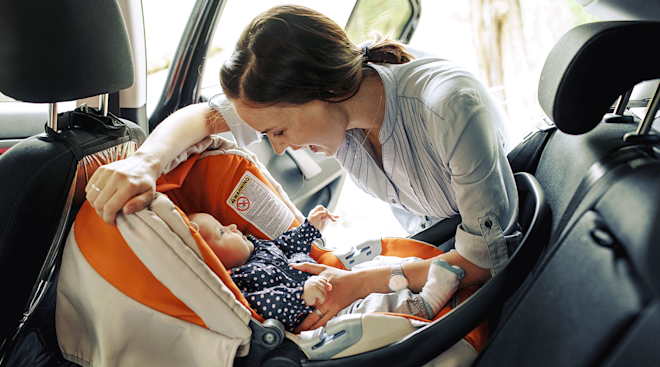What You Need to Know About Flying With Breast Milk or Formula
By now we all know the drill: When packing a carry-on for an upcoming flight, you either leave the liquids out or make sure they’re in containers no bigger than 3.4 ounces and stored in a clear, quart-size Ziploc. But when you have a baby, suddenly that liquids rule looks a lot more daunting. Maybe you’re flying with your child and their bottles of formula—or maybe you’re a breastfeeding mom who has a stash of pumped milk to bring home. Either way, don’t worry: In the US, there are special exemptions that allow you through TSA security, as long as you follow a few simple rules. Here’s what to know about flying with breast milk or formula.
Formula, breast milk and even juice for babies and toddlers are allowed through airport security in “reasonable quantities.” It can be in excess of the standard 3.4-ounce rule and doesn’t need to be packed in a quart-size bag, and you don’t need to be traveling with a child to bring these liquids along. While that’s generally good news for parents, TSA is vague on what counts as “reasonable.” At the end of the day, each TSA officer has discretion in deciding how much is okay to take with you.
Before you begin the screening process, remove the liquids from the rest of your carry-on items (since they’ll have to be screened separately) and let the TSA officer know you have breast milk or formula with you. They may need to X-ray your liquids (which the FDA assures is safe), feel around the container for any concealed contraband or test for explosives, which may require opening the container and/or pouring a small amount into a separate container.
Cracking open your child’s formula or breast milk can make some parents uncomfortable for fear of contamination. Good news: You’re completely within your rights to inform the TSA officer you’d rather not have your liquid opened or X-rayed. In that case, you may have to undergo extra security steps, like agreeing to a pat-down or having your other carry-on items screened.
Ice packs, frozen gel packs and other accessories needed to keep your milk or formula cool are also allowed. Just note that if your ice is slushy or partially melted, it’s subject to the same screening as your liquid. These rules are applicable when traveling in the US; when flying internationally, check the country’s individual regulations.
A while back, it wasn’t uncommon to hear of moms flying with breast milk who ran into difficulties while trying to get through security. Some went through lengthy screening processes that made them miss their flight; others had to leave behind ice packs needed to keep milk cold, and others still ended up dumping their precious liquid gold. So in 2016, President Obama signed the Bottles and Breastfeeding Equipment Screening Act into law, which ensures that TSA agents receive ongoing training to make sure families flying with breast milk receive reasonable, consistent treatment. Anecdotally, things seem to have significantly improved.
Still, it’s best to be prepared. Here, some top tips for helping you (and your milk or formula) get through security hassle-free.
• Leave extra time to get through security. Ideally you sail through security with zero problems, but given the nature of Murphy’s Law, it’s smart to give yourself some wiggle room. Build at least 30 extra minutes into your schedule so you’re not stressed about missing your flight.
• Print out the TSA rules. It’s important to know your rights—and to be able to point to those rights if someone happens to challenge them.
• Ask an airport eatery to fill your cooler with ice. If after clearing security you find yourself without enough ice to keep your milk cool, head to the nearest airport coffee shop or restaurant and kindly ask an employee to fill your cooler. They’re usually more than happy to comply.
• Consider checking your milk. A lot of moms prefer to travel with their breast milk in their carry-on and not let that liquid gold out of their sight (and we don’t blame them). But know that checking your breast milk in your luggage is totally an option. You can choose to pack your milk cold or frozen—just consider how long your trip is. Per CDC guidelines, fresh breast milk can safely be stored in an insulated cooler with ice packs for up to 24 hours. At refrigerator temps, frozen breast milk will thaw in about 12 hours. If you expect your trip to take longer than that, you’ll need to pack your milk using dry ice. Check your airline’s specific policies on how to transport dry ice.
• Consider shipping your milk. If you don’t need your breast milk or formula with you, you can skip any hassle of flying with breast milk and simply opt to ship it! Companies like Milk Stork will provide the proper packing containers and overnight it home. It doesn’t get easier than that.
Published December 2018
Plus, more from The Bump:
Navigate forward to interact with the calendar and select a date. Press the question mark key to get the keyboard shortcuts for changing dates.





















































